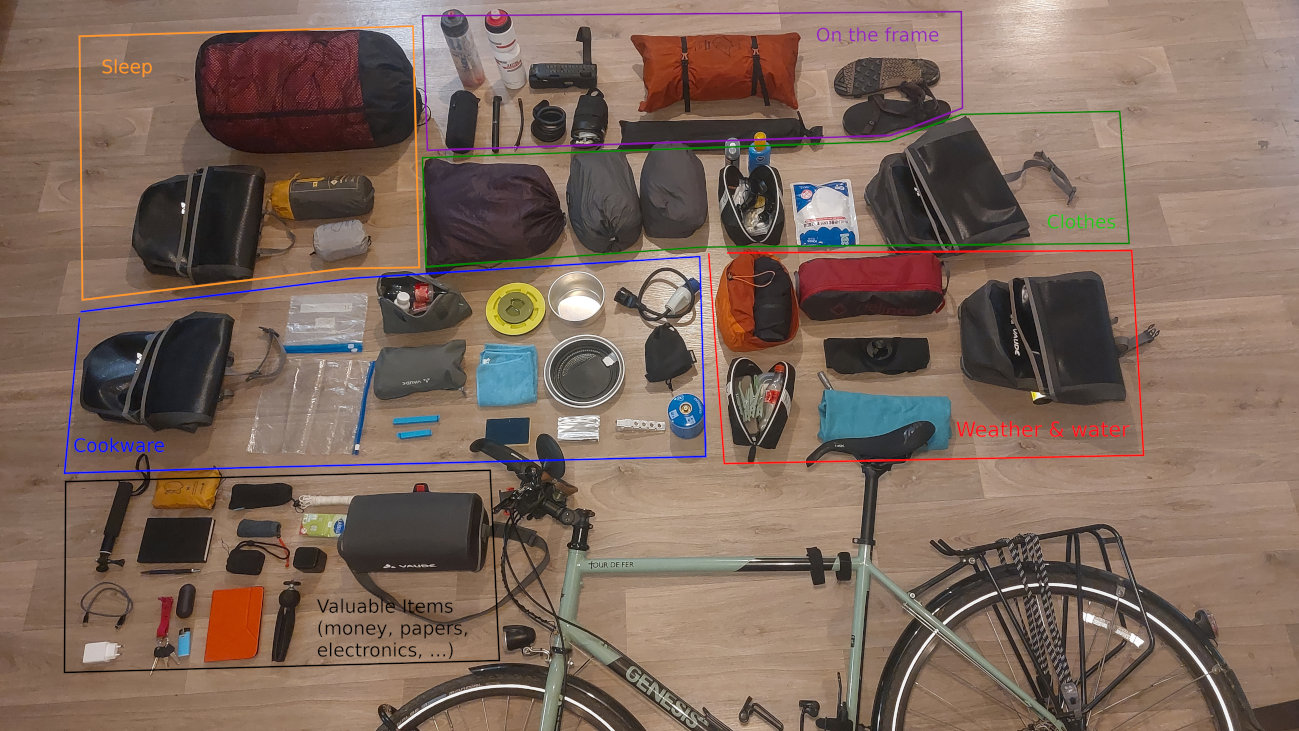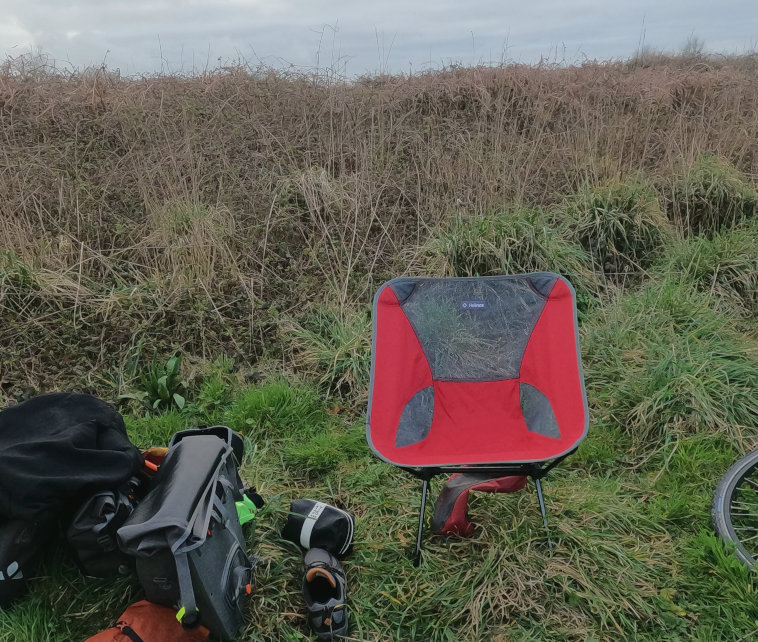Following is the list of items I brought with me. This is surely not a perfect list since I'm relatively new to this kind of trip. The list might evolve along the journey. I will try to keep it updated.
The Green Baron
Empty bike weight: 16.8 kg
The Green Baron is the name of my bike. As a noble steed and my main companion for this trip, it deserves an honorable name that highlights its lagoon-water glint. It is a second hand Genesis Tour de Fer 20 Flat Bar that I got in a very good condition. The previous owner barely used it.
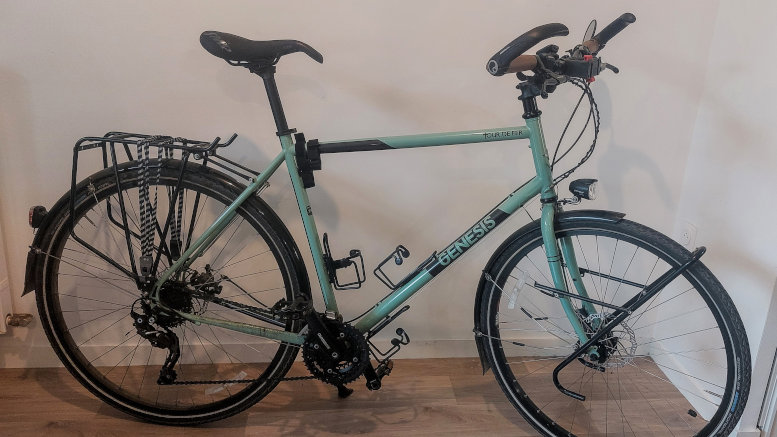
The bags
Total transport capacity: 95 L
Total weight: 23.4 kg
- 2 rear bags (Vaude Aqua Back) of each 24L
- One bag is used to store clothes and medicine.
- One bag is used for everything that can be wet (waterproof jacket and pants, shower, hygiene).
- 2 front bags (Vaude Aqua Front) of each 14L
- One bag is used for the sleeping gear (sleeping bag, mattress and pillow).
- One bag is used for the cooking gear (stove, pot, pan, etc.), food and also the big repair tools (spare chain, brake pads, etc.). Plus everything I might pick along the way.
- 1 handlebar bag (Vaude Aqua Box) of 6 L. It contains everything valuable (money, passport, key, phone, etc.) and I always take it with me.
- 1 tent (Jamet Sella 2) packed at roughly 12L
- 1 saddle bag (BTWIN Sacoche de selle 500 M) of 0.6L dedicated to first aid kit. Everything that should be access quickly.
- 1 bottle cage bag (Topeak Cagepack) of 0.75L that contains the tools for a quick fixes (spare tube, allen keys, ...).
Detailed list
Thinking the biketouring gear through is essential when preparing for long trips. Everything on this list is a compromise between pack size, weight and usefulness. And price of course.
Every kilogram that I bring along with me is two kilograms I have to climb with.
Every space occupied by a "nice-to-have" item is a bunch of pasta I can't store.
Every bag I add to the frame is a bulky addition that I have to hand carry when not on the bike.
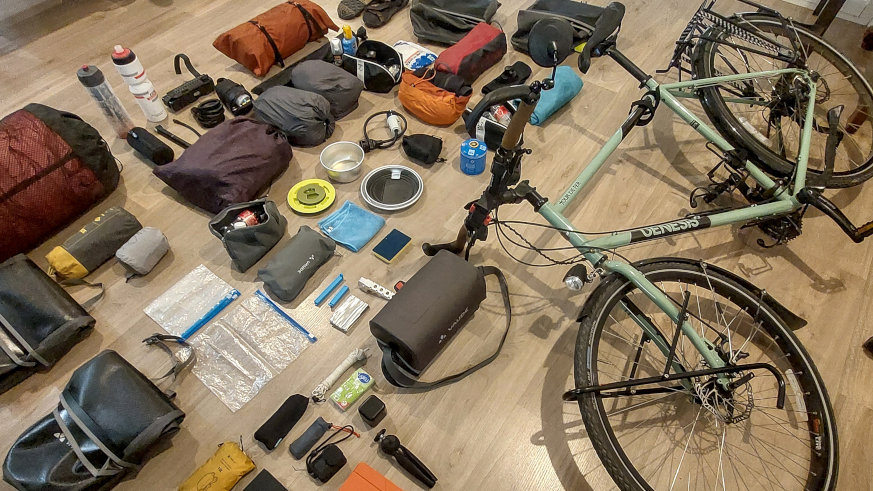
Sleeping
This is probably the most important gear of the travel both for physical endurance and mental health. Without a good sleep, I won't last long on this tour. Maybe a week or two, no more. The tent has to be my safe place where I can get some good rest but also shelter from rainy evenings.
As I'm quite tall, the dimensions of the tent were critical to me. My previous one was too short (I had to sleep diagonally to fit in :/ ) and this was the main reason I wanted to change. Last summer, I found the Jamet Sella 2: it fit my needs and was on a sale. This tent may not last as long as higher-priced concurrents but it should (I hope) hold for 6 months.
The only downside of this tent is the poles length when folded. At around 60 cm, they force the packed tent to be quite elongated on my bike. I managed to circumvent this by strapping the poles to my top tube and packing the fabrics in my old tent sack whose form-factor fits better on my bike.
Then there is the mattress. I went for inflatable because of the packing size. I'm really happy with the Decathlon's Inflatable Mattress MT500 air XL. It is really easy to inflate (I counted 10 big blows, 9 on good days). I also bought the Decathlon's Inflatable Pillow MT500 which is comfy because of the integrated plush but stays compact enough when deflated.
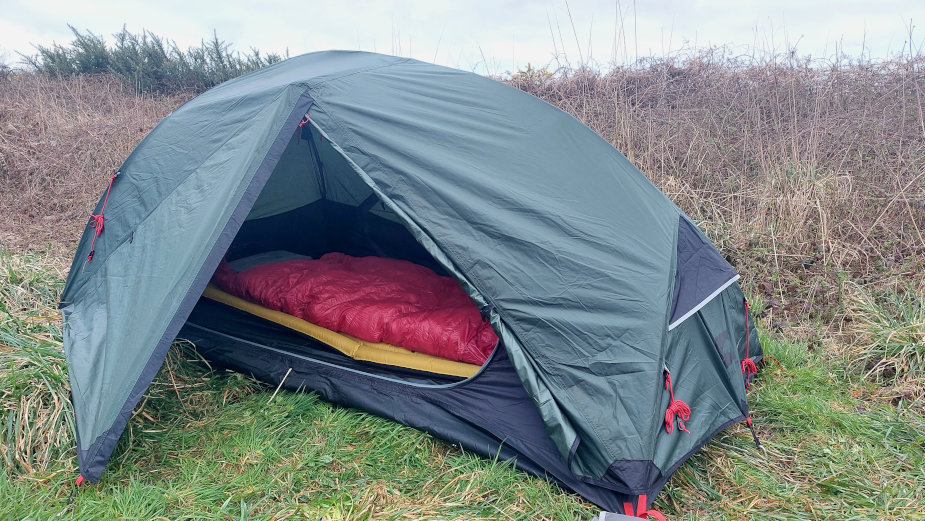
The last important item I brought is a good sleeping bag. As I needed to get a new one for this trip, I chose to get a high-end one that should last a long time (more than this trip). After a long comparison of many brands, I found that the best price/quality compromise was the Polish down-filled Cumulus Panyam 450. With a 0°C comfort temperature it should be enough for cold European summer nights. Plus the fact that you can customize every aspect (size, fill ratio, fabrics, etc.) is just a big plus for me : I got a few extra centimers in length to fit my 2-meters body.
This is my first down-stuffed sleeping bag and I am really impressed by how much it can be compressed. I manage to fit it, along with the rest of the sleeping gear, in a single 14L vaude bag. And I can fit more stuff if required but I prefer to avoid compressing it too much: over a long time, it may damage the down.
To finish on the sleeping topic, I use a Cocoon Cotton MummyLiner. I use it either as a sleeping bag liner or as a mattress cover depending on the night temperature. I personally prefer the toucb of cotton over silk and I think the lose in packed size and weight is worth it.
Food and cookware
I grew up in a family that loves good food. My father always cooked diverse and healthy meals. So nutrition is something I consider quite important, I won't live off sandwiches and snacks for 6 month.
As my budget can't fit a restaurant every day, I plan on cooking at camp. To my deception, I can't bring a 3gk/30cm cast iron pan with me and I had to restrict myself to minimum size and weight !
I shopped at Trangia for the main cookware. I picked my utensils from the Trangia Stove 25 1-UL kit. Their ultra-light plate, pan and pot is well suited for this kind of travel. I hesitated with the non-adhesive version as it should last longer. We'll see how well the aluminum holds over time.
However, the stove is not from Trangia. My parents offered me a gaz stove on Christmas: Optimus Vega with an adapter for Campingaz bottles which are easier to find in Europe. It quickly heats the Trangia pan and pot and the fact the gaz bottle is deported means it's quite low and stable on the ground.
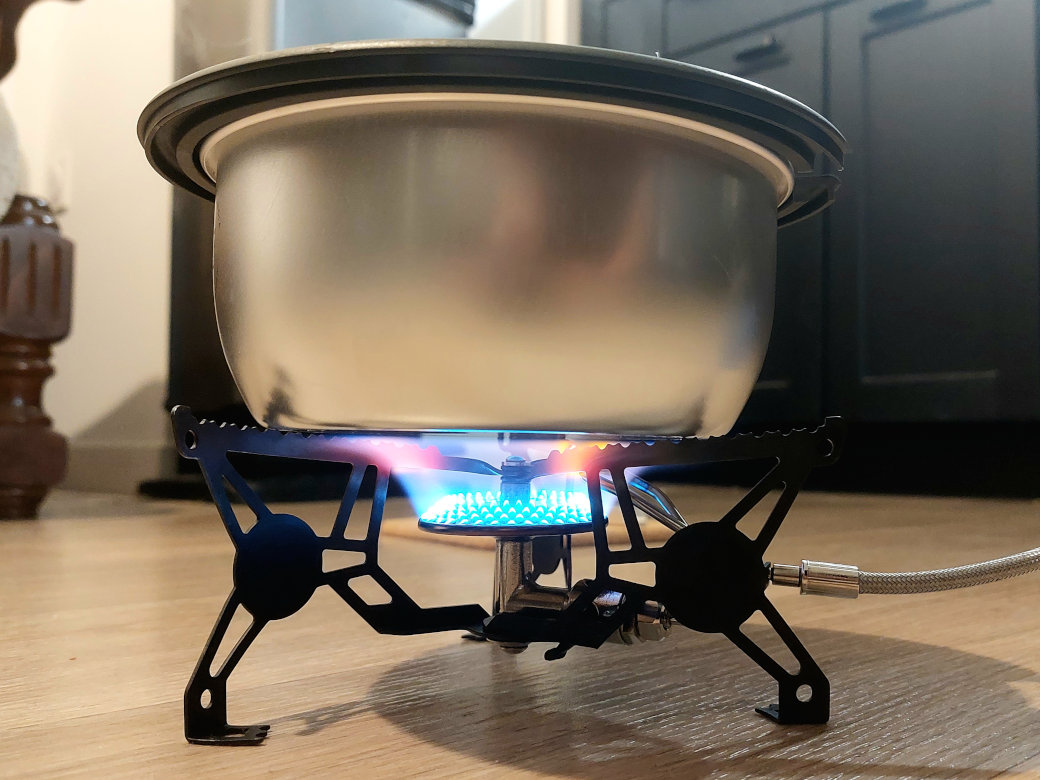
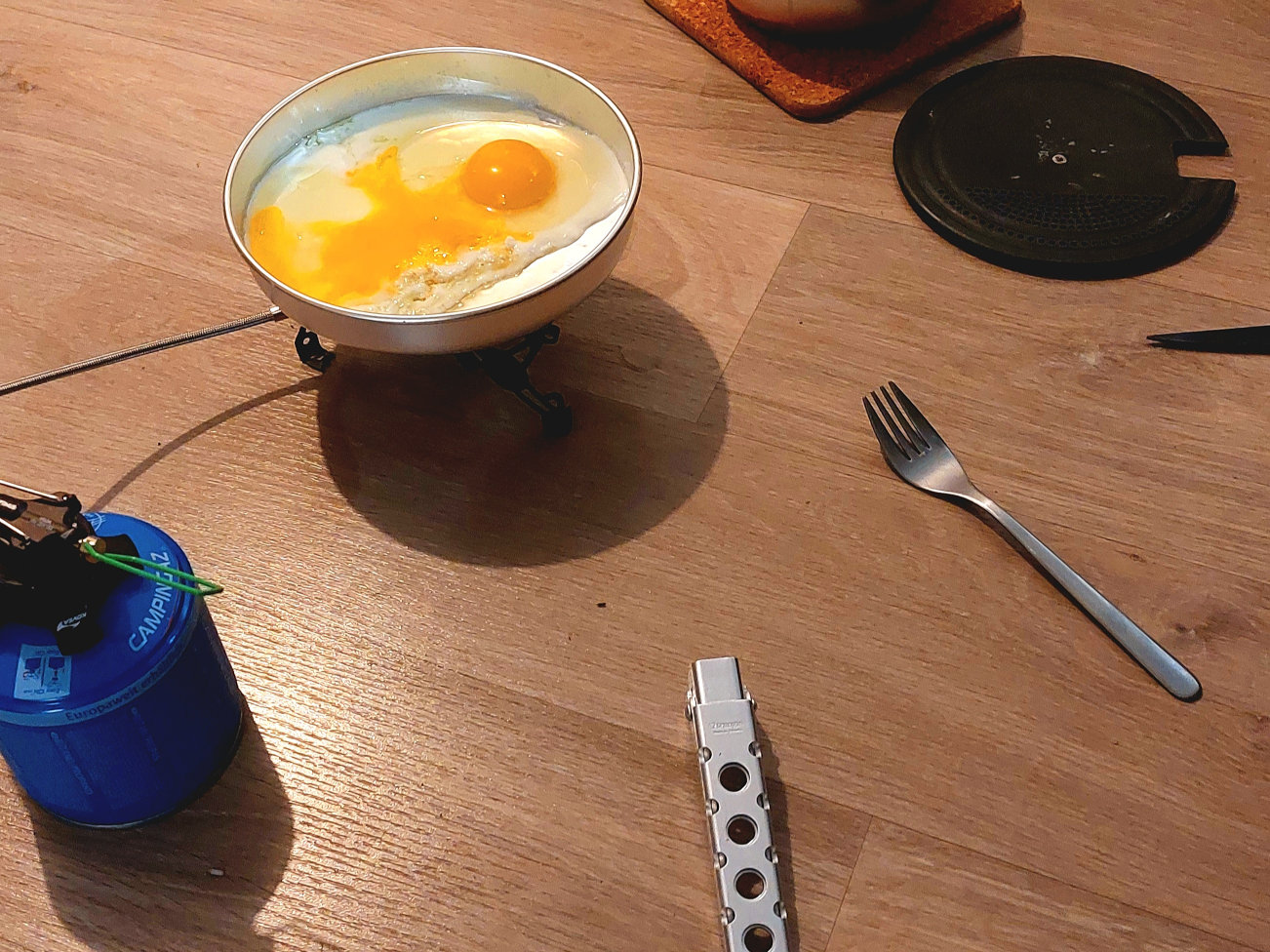
Aside from these essentials, I brough various little items to ease my life :
- Spice plastic bottles, oil
- The Sea-to-Summit X-Seal&Go Set to store excess food
- An Opinel knife and a folding spork
- A sponge, dish-washing liquid, a microfiber cloth
Clothes
Obviously, I can't bring 6 months of clean clothes with me. I have to bring as few items as possible without impacting my hygiene (I don't want to be spotted kilometers away when camping). The solution is, of course, hand-washing everyday. This is tedious but mandatory to keep everything fresh and clean while not taking much space in the luggages.
As most of my time is spent on the bike, sweating, I have 2 sets of cycling clothes that I can alternate. When arriving at a campsite, I can wash and hang one. If it's not fully dry by the morning, I can wear the other set.
Among the 2 sets of cycling clothes, one is a bib short that I wear on "sportive" days. The other is a mountain-bike-style short that I prefer to wear on casual days. It does not look as "cyclist" as the bib short and blend in more when going through cities.
After setting up camp, I take a shower (using the 4L Ortlieb water bag) and change my clothes. I wear a casual outfit with a "panta-short" (I don't know the proper name for the pants that can be transformed into shorts so I like calling them "panta-shorts"). For cold evenings, I have a combination of multiple warm layers I can use : 2 light fleece jackets, T-shirts and a merinos-wool shirt beneath everything. I will probably never need all the layers at once. Unless I miss a turn and end up in north sweden somehow. But I can wear a combination of 1, 2 or 3 layers to accommodate for any temperature.
On the dreadful rainy days, I wear a fully waterproof outfit. A jacket and an overpant keep the rain away. I have to admit, they won't fully keep me dry as I'm sweating quickly in it. I haven't found the perfect solution yet (there is still room for improvement on my equipment). Nevertheless, being sweaty is not as bad as being a wet sponge. In addition, I swap my shoes for a pair of sandals. The shoes are a pain to dry so I avoid wearing them in wet conditions.
Electronics
Some mad travelers still go with a paper map and no phone. I can't. I find a GPS or an Internet access so comfortable and useful. Even though that means spare batteries and recharging them frequently. Plus, how could I feed this blog without an phone ?!
My main station is of course my smartphone. It is a fairly recent Samsung Galaxy A52s 5g. So far, I'm content with it: it has a good battery, is reactive, is weatherproof, and takes okay-ish photos. My Internet plan includes enough data in Europe for basic needs: messaging, calls, satellite maps, quick search, translation. However I will have to restrict my usage: no more Youtube or Netflix for hours before going to sleep. *sad noises*
The main usage for my phone is GPS routing and planning. I extensively use OSMAND which is a great FOSS project (Free and Open-Source). It has many features, different map aspects, and so far I always managed to find what I needed. But this is also its main issue: the many features means there are confusing menus and options everywhere. I also use Google Maps for satellite images and restaurants/hotels/museums/... But my cybersecurity background prevents me from using Google products too much. I have to admit, the information is often more precise on Google Maps, but this comes at a price, paid in privacy.
The second important usage I have is the camera. As this is a mid/low-price smartphone, the camera is far from perfect. The grain is quickly visible in low luminosity, the zoom is purely digital, I can't play with focus or aperture, etc. But still it takes photos that are good enough for small displays such as phones. I could not reasonably fit a better camera in my budget, maybe for next time.
However, I bought a GoPro Hero 9 to make some cool films and vlogs. I might update this blog with some clips here and there but I plan on making a Youtube channel after the trip with all the videos taken. I can't do video editing on the road so you will have to wait next winter for a proper vlog experience (unless I lose my motivation by then).
For long evenings in front of a superb sunset, I read books with a Kobo Clara 2E E-reader. I can't spent my evening on Youtube (my Internet plan won't last a week like that), I can't bring 25 kg of books with me (my endurance won't last a week like that), so an E-reader was the obvious choice.
Bike equipments
My bike equipment is mostly the default one. As most components are still new, in very good condition and build for biketouring, I did not change much. It's still equipped with :
- Shimano Deore derailleurs
- a 3-speed 44-32-24T front derailleur
- a 10-speed 11-34T freewheel cassette
- Promax Render-R mechanical disc brakes
- Sun Rhyno Lite 700c wheels
- Schwalbe Marathon Mondial tires (best investment ever !)
The few changes I made were focused on comfort and ease of use. This means I replaced/added :
- The saddle for a SMP TRK Medium : the previous owner of the bike had a cheap, gel-full saddle that got me sore after 1h, so I quickly changed it.
- The handlebar for an old Rockrider flatbar with an Ergon GP5 BioKork grips that offer many hand positions and prevent hand numbness.
- A Decathlon e-bike kick stand : once you try the kick stand there's no going back. It's so easy to park your bike and not need a wall to carefully lean against. Simply, kick it, lock it and you're good. No worries it will fall or scratch along the wall. This particular kick stand is tagged for e-bike as it is meant to support heavier bike. This means I can use it with all the bags on the bike, it won't easily break.
Repairs and tools
Last topic of this extensive list, but not the least. Tools are mandatory on a trip like mine. I will surely have a flat tire, break something or need to tie together two pieces of equipment. I've tried to compose a list of all the equipment I might need (from changing my tubes to welding my frame) and I kept what was reasonable to bring along.
As I'm staying in Europe, which is fairly dense, I will probably always find a bike shop within 50 kilometers. They should have any tool I need to fix my bike. As long as I'm dealing with reparations that can wait a whole day, I don't need a tool for this.
But, on the other hand, I don't want to depend on local shops to fix everything. There are many tweaks that can easily be done with the right tools. I brought these tools with me.
I separated my tools in 2 categories :
- The tools needed for small fixes (i.e. flat tires and screwing bolts) are quickly accessible. My multi-tool, a spare tube and some patches are stored in a bottle cage bag on the frame and a mini-pump is attached to the frame. For instance, in case I puncture a tube, I simply stop and get off the bike, I grab the bottle cage bag which is under my bottom tube and I have everything I need to fix the issue and continue.
- The tools for big reparations and care are stored at the bottom of one of my bag. Yes, they are not easily accessible but I don't mind. If I need one of these tools, either I am at camp or this is serious and I have to spend the next hour on the side of the road fixing my bike. Either case, I don't mind spedning 1 minute emptying my bag entirely and reaching for the bottom of it. This set of tools includes chain oil, spoke tensioner, spare brake pads, spare chain and quick links, pliers, zip ties, spare nuts and bolts, carabiners, AAA batteries, ...
Extra-comfort bonus: the camping seat
Then there is my extra-super-comfy-bonus item. This is the only item, that I do not find mandatory but adds a lot of comfort every day : the Helinox Chair One XL. A folding light-weight camping chair.
Yes I could probably sit on the grass and be fine. But this is such a pleasure to avoid itching bottom while cooking, to avoid humid grass while sipping a morning coffe, to avoid leaning against an uneven tree trunk while trying to rest for a bit, to avoid hurting my back trying to sit up while I read before the sun set, that I carry this chair even though it takes around 7 L and 1.5 kg. This is worth it.
Everything has to fit in
